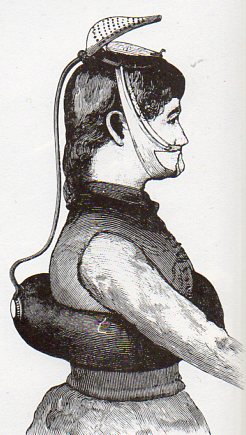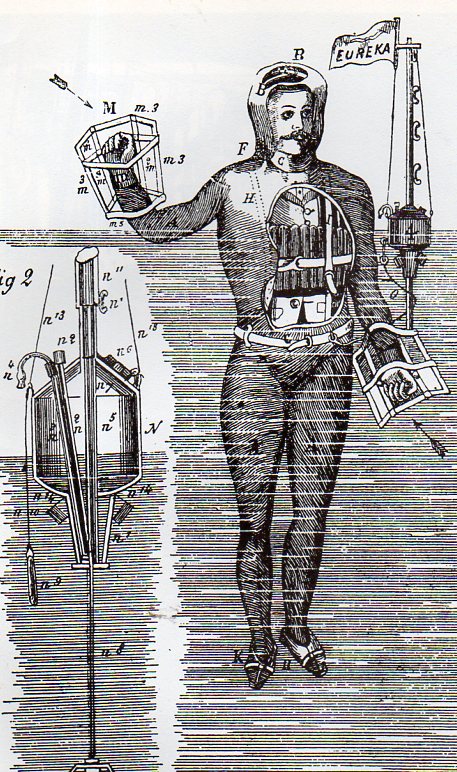JF Ptak Science Books Post 1743
These creations weren't so much about exploring the innerEarth than they were about surviving in the outermost, shallowest bits of its depth. Survival gear for The Great Unpleasantness in disastrous adventures at sea was relatively scant for hundreds of years, although the nineteenth century did offer a number of new, Victorian technolust attempts for survival-at-sea.
I know that this first contrivance in some of its particular parts looks enormously compromised, but really the stuff attached to the woman's head just allowed her to breathe about 10 inches higher than her mouth, though it seems to me that this air-catcher might catch more water than anything else. Still, it was an interesting attempt at keeping people floating above the water when in peril.
 In general though it seems to me that most of the big adventures in wearable life saving devices were big indeed, big and heavy--if there was just a little more room for a small engine, wed' be in the Steampunk realm, as can be seen in this magnificent attempt by T. Beck in his 14 March 1876 patent:
In general though it seems to me that most of the big adventures in wearable life saving devices were big indeed, big and heavy--if there was just a little more room for a small engine, wed' be in the Steampunk realm, as can be seen in this magnificent attempt by T. Beck in his 14 March 1876 patent:
This was somehow an improvement over a more complicated but still more sensible device that appeared earlier in 1869, the work of Captain John Stoner. He exhibited his creation in NYC off the piers in the East River as demonstration of the suit's effectiveness, the whole of which was big news, appearing in the July 17, 1869 issue of Scientific American. The suit was made of rubber, and was insulated and was equipped with a personal buoy which carried a "Eureka" flag and had a compartment filled with food, water, lighting materials, cigars, and of course reading material to help pass the time. The hand-flippers on the other hand look like a very good idea.
A more streamlined idea of the Stoner suit appeared in F. Weck's patent application of 24 October 1876, again using a rubber suit, but this time the safety device was far less cumbersome, and equipped with little more than an interesting-looking breathing apparatus connected to a towed buoy which of course flew the American flag.
Since I mentioned the possibility of cigars in the above-mentioned case, I should also point out that it took several decades for someone to patent a waterproof case for swimming with cigarettes, "in case the swimmer wanted to swim out to some rocks and then relax with a cigarette".
G. & C. Palmer came forward with another unusual idea in their 11 November 1873 patent, using chess-like figures to pus their idea of an expanding/collapsing life preserver vest, which would move in rhythm with ocean waves and theoretically protect the wearer from being overcome by bad swells. I have my extended doubts about this one.
Most of the patent applications that I've looked at tonight seem to lake one critical element--locomotion. Of course they're assuming that the life vest is doing little more than keeping the wearer from drowning (though sometimes comforted with cigars and flags). A. McDonald went a little further with his invention (patented 17 January 1882) by putting a screw propeller on the belly of his life vest. It all looks very heavy and sinkable.
F. Vaughan continued on the idea of a big, heavy wetsuit preserver by making his even bigger and heavier. This 1879 creation looks to have about 10 inches (or more) or rubber in the suit, which means that if the thing wasn't water-tight, and that if even a very slight leak developed, the wearer would no doubt sink like a stone.
A. Traub (in 1875) created something that was much less bulky and more accessible, a sort of unfolding life vest, that seems really not to do much of anything, but which was at least light:
E.H. Brown (in 1884) had a somewhat different approach to the "life-saving" idea, turning the survival bit into a bucolic if ungainly adventure/romp device for the vacationer on the coast--the "hammock canoe":
Though as cumbersome as this device seems it is quite in step with its contemporaries, at least so far as in being not-very-usable goes:
And somewhere in all of this was the occasional good-looking idea that evidently got caught in the undertow of the heavier/punkier outfits--but in them you can see the beginning of the idea that would eventually work:



Comments